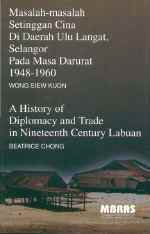 |
Monograph 30
The Prize Winning Sheppard Memorial Prize Historical Essays 1998
109pp. Size:140x220mm. Softcover
1999
This monograph presents the essays of the joint winners of the first Sheppard Memorial Prize for 1998/1999. The award is based on the best final-year undergraduate History Honours Thesis or Long Essay submitted at any university
in Malaysia, Brunei and Singapore. The prize was established to commemorate the life
and work of the late Tan Sri Mubin Sheppard, and more particularly his contributions through his work for the MBRAS, as well as to scholarship in Malaysia,
Brunei and Singapore.
The first two joint prize winners were Miss Wong Siew Kuon of Universiti Sains Malaysia, Penang who has submitted a paper in Bahasa Malaysia
entitled "Masalah-Masalah Setinggan Cina di Daerah Ulu Langat, Selangor pada Masa Darurat, 1948-1960" (The Problems of Chinese Squatters in the Ulu Langat District of
Selangor During the Emergency, 1948-1960) and Miss Beatrice Chong of the National University of Singapore, for her essay entitled "A History of Diplomacy and Trade in
Nineteenth Century Labuan". Credit should also go to their supervisors: Miss Wong was supervised by Dr. Leong Yee Fong, an acknowledged authority on the history of Malaysian
Chinese political activism while Miss Chong was supervised by Professor Ernest Chew, a distinguished authority on the history of the island republic.
Miss Wong's essay, though written in Malay, tries to piece together the history of the Chinese immigrant society in post-war British Malaya and some of the conditions under which
this particular section of the Malayan population used to live. The inadequacy of the British government's policy response to the influx of Chinese immigrant workers from mainland China into
Malaya was to manifest itself in the emergence of squatter areas, mostly found around the fringes of urbanized settlements in locations that were then relatively remote. The example that Miss Wong
has employed as the focus of her study of the Chinese squatter problems are the areas of Cheras, Broga and Semenyih - all found in the Ulu Langat District in the southern part of Selangor and located
not far from the administrative
capital of Kuala Lumpur. The essay then goes on to examine the impact this population anomaly had on the emergence of the Communist movement in Malaya and the sustained Communist insurgency, commonly referred to in the history of modern Malaysia
as the "Emergency of 1948-1960". a significant portion of the essay goes into some detail into the execution of the Briggs Plan - a resettlement plan mounted by Sir Harold Briggs to weaken the influence of the communists on the Malayan population
in squatter areas,
particularly the Chinese - and some of the problems encountered by the newly-settled Chinese squatters of the Ulu Langat District in the "New Villages", as their area of residence was called. Some of the problems dealt with by Miss Wong in her essay
were disruption of food supply, restriction and constant monitoring of residents' physical movements, and more importantly the abandonment of their allotments and property from which their incomes had been derived. In her research, Miss Wong has had access
to the Selangor Secretariat and the British Adviser's Files mostly found in the Malaysian National Archives as well as resorting to oral interviews.
Miss Chong's thesis on the history of the rise and fall of Labuan as a colonial possession is a well argued essay on a subject not much in favour with historians. Indeed, its obscurity and unpopularity allows Miss Chong ample opportunity to explore
in some detail the background against which Labuan's rise was envisioned and what went wrong with the vision subsequently, which as Miss Chong stresses, is a result of external factors
rather than the internal wrangling which took place presumably behind the closed doors of the Colonial Office and the Admiralty in Whitehall. Having proceeded from the reasons behind the British Government's decision to occupy Labuan in 1846 - it was then under
the control of the Sultanate of Brunei which obviously could do little to supress the endemic security problems posed by rampant piracy in the area - Miss Chong goes on to dwell at some length on the colony's subsequent inability to fulfil the
expectations that was thrust upon it at the outset. Miss Chong ends her essay on a somewhat doleful note, pointing out to readers that by the 1870s Labuan was irretrievably mired in obscurity and was rapidly
becoming a mere outpost of the British Empire rather than the robust trade and economic centre that it was supposed to become. It was apparent that the British Government saw that the island possessed a certain amount of
strategic potential despite its failure to transform itself from a backwater to a robust trading settlement. This acknowledgement was embodied in the fact that the British Government in 1906 decided to place the island as part of the Straits Settlements following a
17-year hiatus during which it was administered by the British North Borneo Company. Labuan eventually became part of Sabah when the merger with Malaysia took place in 1963 but its status was once again altered
when Sabah offered it to the Federal government in 1984, since which date it has been referred to as the Federal Territory of Labuan.
Both essays are a tribute to the sound scholarship of History undergraduates in Malaysian and Singaporean universities, and stand as testament
to the promising future of this discipline - in safe hands under the tutelage of scholars of the calibre of Dr Leong and Dr Chew - in these tertiary institutions in the years to come.
Contents:
Masalah-masalah Setinggan Cina di Daerah Ulu Langat, Selangor, Pada Masa
Darurat 1948-1960 by Wong Siew Kuon
A History of Diplomacy and Trade in Nineteenth Century Labuan by Beatrice Chong
Bibliography

|